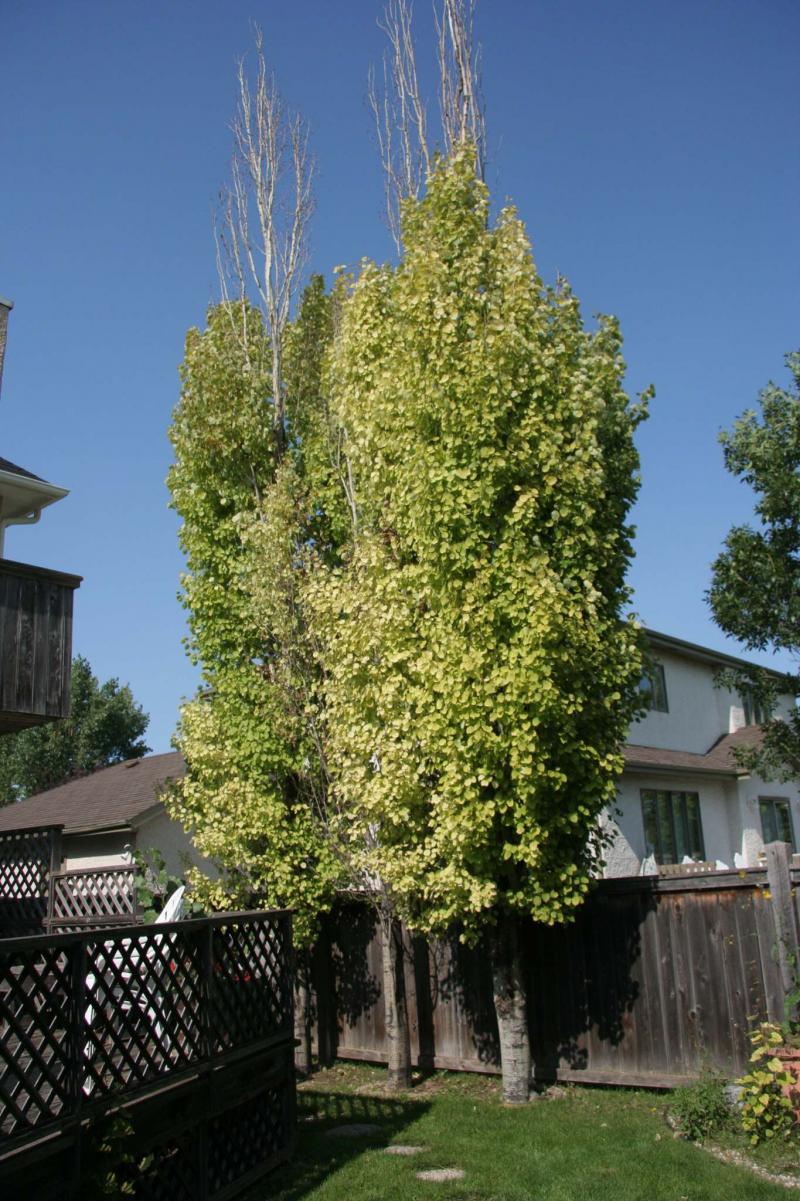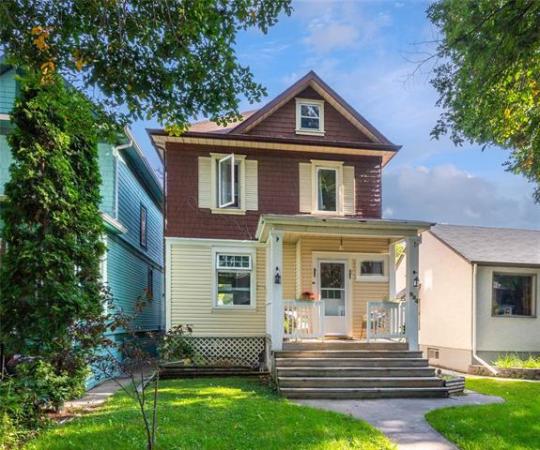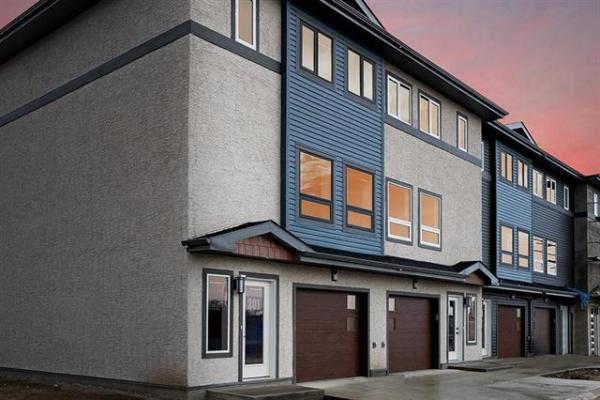
Michael Allen / Winnipeg Free Press
Dying and dead Swedish aspens planted very close to the property boundary fence.
Two or three times a month, I receive calls and/or emails from readers complaining about problems with their own columnar poplars or with their neighbour’s columnar poplars. Typically when I visit properties and assess clients’ tree issues who have these poplars, I will invariably see a small row of very tall poplars crowded near a neighbour’s fence either on my client’s side or on the neighbour’s side of my client’s fence. Let me state at the beginning that it is my professional opinion that these towering menaces really do not have a realistic place in typically small urban yards adjacent to buildings and fences.
The most commonly currently available columnar poplars are tower poplar and Swedish aspen. Contrary to what some arborists might say, I do not dislike all poplar trees — just the ones that are not truly indigenous to the Manitoba landscape.
The indigenous ones, that have been part of our Manitoba landscape for thousands of years, are some of my favourite trees. These include plains cottonwood, large tooth aspen, balsam poplar and even the lowly trembling aspen. Although our indigenous trembling aspen is indeed a native of the poplar family, it takes careful planning to place it preferably as a cluster in an urban landscape setting having sufficient area to spread its roots as is its natural tendency.
I am constantly amazed as to why urban property owners put up with the inconveniences, nuisances and potential hazards of having one or more large hybrid poplar trees near their houses, especially on small lots. I have spent my professional life (presently 47 years) observing and studying trees in Canada and around the world. Only on the Prairies is the notion that the positive features of a large shade tree can overshadow its negative traits.
I know that it is difficult and time-consuming to grow large trees on the Prairies; so I can understand some people’s tolerances for the bad features of poplar trees.
Now, I do have a fondness for very large trees, and will go out of my way to find them, but I draw the line when my professional assessment puts "large tree" and "hazardous" in the same sentence. I once advised a property owner to remove a 20-metre-high northwest hybrid poplar tree. It had a number of large vertical cracks in the trunk, including a wide lightning crack on one side of the trunk leading to a hole at the base. The ground around this tree near the base of the split was also cracking up toward the house.
The owner was justifiably concerned as the tree had quite a sway in the wind. I have a device called a Resistograph that is able to give me a graphical print-out of the condition of the wood inside trees: whether or not it is solid, checked, decayed, open cavity or a combination of these features. This 76-centimetre-diameter tree had a large hollow core with remnants of decayed heartwood and its only means of support was a doughnut-like ring about 14-cm thick just inside the bark. This tree was extremely hazardous.
Most planted poplars around homes and parks, and in towns and cities in southern Manitoba, are types of hybrid poplars; that is, they have been developed as a cross between two or more species or varieties of poplar trees. Typically they are propagated through cuttings or slips in what we refer to as vegetative reproduction. Most hybrid and cultivated varieties of poplars have three common features: they are all in the willow family referred to by botanists as Salicaceae; they all grow quickly and rather tall for their age; and they tend to develop many structural and disease problems as they get older much earlier than any other kind of tree except willows.
Over the course of my 47 years as an urban forester, tree diagnostician and arborist, I have received more complaints about columnar poplar trees than any other tree, especially when I was the City of Winnipeg forester. It is very common for people to refer to the hybrid poplars as cottonwoods owing to the cotton-like fluff that some of them (female trees only) produce.
The columnar Lombardy poplar had been a favourite with land owners for many years. Even today, many people still call their towering poplars: "Lombardy." With age it quickly deteriorated in North America, but it is still planted in some areas of southern Italy. Tree growers developed the current common columnar poplars: Swedish aspen and tower poplar, to mimic, in a sense, the much beloved "Lombardy."
The magnificent native plains cottonwood is by far the largest and most massive of all southern Manitoba trees, and unfortunately a number of them do find their way on to small urban yards. It is one of my all-time favourite Prairie trees for the open landscape near wetland areas and water bodies such as streams and rivers — where, in my opinion, they belong.
How do these trees get so decadent at an early age? In compacted urban clay soils, poplar as well as willow tree roots tend to grow just below or at the surface of the soil. They have a tremendous need for water so the roots come near the surface to take advantage of any rainfall or irrigation. When these trees are young, their bark is quite thin. Lawnmowers can open the root bark and establish entry points for various diseases. The early signs of this problem will be the discolouration and wilting of the leaves that become very decadent and will ultimately die.
Trees have a survival mechanism to limit the spread of wood decay into healthy wood. A special wall of cells compartmentalizes the decay; that is, the cells seal off the decay area from the healthy area. If the tree is continually wounded, wood decay will enter the once-protected healthy area of wood. Repeated damage, especially to the roots and the lower trunk, will ultimately result in almost complete wood decay of all the wood inside the tree trunk.
Structurally, when the tree has virtually nothing to hold it up and it will collapse. Remarkably, I have seen large poplars support themselves with a thickness of only 10 cm of solid wood inside their bark. Eventually they collapse. Prior to this collapse, the tree will let its owner know it is under severe growing stress. Trees that have been stressed by root and lower trunk wood decay will start to produce smaller and fewer leaves that lose their colour, especially near the top of the tree’s crown. With time, the crown has a distinct thinned-out look as leaf density is dramatically reduced. Portions of the branches in the crown start to die, leaving very noticeable dead branches. Poplars will also produce tell-tale signs of stress in the form of trunk or exposed root swellings referred to as disease cankers. Many poplars often collapse before the branches show signs of death.
There is a current trend, at least in newer Winnipeg neighbourhoods, in planting narrow upright poplars such as tower poplar and Swedish aspen in small yards near the property boundary. Often, the plantings are only a few metres apart. Without question this is the number one complaint I receive from property owners who have neighbours growing these trees close to their property boundary fence.
The competition between these trees will also stress them as they age. In 30 to 40 years, or less, these trees will start dropping very large upright stems and branches. Thick roots will start appearing in the grass. The damage can be considerable. Rows of these upright poplars are sometimes planted fairly close to swimming pools, or even one or two metres away from the foundation of houses.
Poplars, along with their willow cousins, have roots that will aggressively seek out the moisture around a pool and in weeping tiles around houses, especially during hot, dry weather. In Winnipeg, poplars have a reputation as being the bad neighbour tree.
Over the years, I received many hundreds of complaints about privately owned poplar trees affecting neighbouring yards. In a few instances I have even appeared in small claims courts as a knowledgeable witness explaining how the roots of these trees damage property.
I have a suggestion for homeowners who would like to grow a non-damaging columnar tree: try columnar nannyberry viburnum. These trees will likely grow only to four to five metres in height; produce gorgeous creamy blossoms; produce prolific bluish purple berries that will attract all kinds of song birds; and, the tree will fit into limited spaces. What more would a gardener want who has a rather small yard?
If you are an owner of a poplar, or even a willow tree, growing in a typical urban yard, you might want to think about the value that tree has for you and your neighbours. Do you want to be the cause of your neighbour’s suffering? Do you want to be the cause of damaging your neighbour’s home — or even yours?
Michael Allen M.Sc.F., RPF (ret’d) is a consulting urban forester, tree diagnostician and certified arborist. He owns Viburnum Tree Experts. He can be reached at 204-831-6503 or 204-223-7709. His web site is treeexperts.mb.ca.
viburnumtrees@shaw.ca



